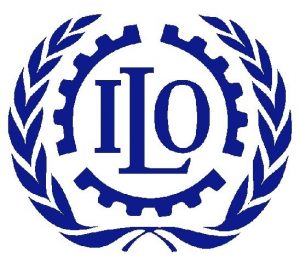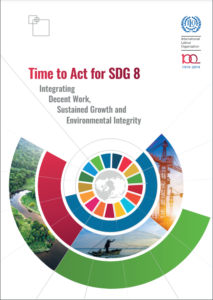Table of Contents
Introduction
Agenda 2030 for Sustainable Development and its accompanying monitoring framework has major implications for national statistical systems worldwide as they face the complex task of producing reliable, consistent and comparable statistics for an increasing number of goals and targets. The MDGs had 8 Goals, 21 targets and 60 indicators whereas the SDGs have 17 Goals, 169 targets and 232 indicators.
As a custodian agency, the ILO reports to the UN data for 14 SDG indicators, grouped under 5 of the 17 Goals. Moreover, the ILO’s role in strengthening countries’ capacity for producing high-quality labour statistics has become even more crucial.
Data catalogue
| Indicator | Frequency | Database | Subject | Download (with labels) | Download (with codes) | Data explorer |
|---|---|---|---|---|---|---|
| SDG indicator 1.1.1 - Working poverty rate (percentage of employed living below US$2.15 PPP) (%) | Annual | SDG Labour Market Indicators (ILOSDG) | Working poverty | .csv .dta .xlsx | .csv.gz | |
| SDG indicator 1.3.1 - Proportion of population covered by social protection floors/systems (%) | Annual | SDG Labour Market Indicators (ILOSDG) | Social protection | .csv .dta .xlsx | .csv.gz | |
| SDG indicator 5.5.2 - Proportion of women in senior and middle management positions (%) | Annual | SDG Labour Market Indicators (ILOSDG) | Employment | .csv .dta .xlsx | .csv.gz | |
| SDG indicator 5.5.2 - Proportion of women in managerial positions (%) | Annual | SDG Labour Market Indicators (ILOSDG) | Employment | .csv .dta .xlsx | .csv.gz | |
| SDG indicator 8.2.1 - Annual growth rate of output per worker (GDP constant 2021 international $ at PPP) (%) | Annual | SDG Labour Market Indicators (ILOSDG) | Labour productivity | .csv .dta .xlsx | .csv.gz | |
| SDG indicator 8.3.1 - Proportion of informal employment in total employment by sex and sector (%) | Annual | SDG Labour Market Indicators (ILOSDG) | Informal economy | .csv .dta .xlsx | .csv.gz | |
| SDG indicator 8.5.1 - Average hourly earnings of employees by sex (Local currency) | Annual | SDG Labour Market Indicators (ILOSDG) | Earnings | .csv .dta .xlsx | .csv.gz | |
| SDG indicator 8.5.2 - Unemployment rate (%) | Annual | SDG Labour Market Indicators (ILOSDG) | Unemployment | .csv .dta .xlsx | .csv.gz | |
| SDG indicator 8.5.2 - Unemployment rate by disability status (%) | Annual | SDG Labour Market Indicators (ILOSDG) | Unemployment | .csv .dta .xlsx | .csv.gz | |
| SDG indicator 8.6.1 - Proportion of youth (aged 15-24 years) not in education, employment or training | Annual | SDG Labour Market Indicators (ILOSDG) | Other measures of labour underutilization | .csv .dta .xlsx | .csv.gz | |
| SDG indicator 8.7.1 - Proportion of children engaged in economic activity and household chores | Annual | SDG Labour Market Indicators (ILOSDG) | Child labour | .csv .dta .xlsx | .csv.gz | |
| SDG indicator 8.7.1 - Proportion of children engaged in economic activity (%) | Annual | SDG Labour Market Indicators (ILOSDG) | Child labour | .csv .dta .xlsx | .csv.gz | |
| SDG indicator 8.8.1 - Non-fatal occupational injuries per 100'000 workers | Annual | SDG Labour Market Indicators (ILOSDG) | Occupational injuries | .csv .dta .xlsx | .csv.gz | |
| SDG indicator 8.8.1 - Fatal occupational injuries per 100'000 workers | Annual | SDG Labour Market Indicators (ILOSDG) | Occupational injuries | .csv .dta .xlsx | .csv.gz | |
| SDG indicator 8.8.2 - Level of national compliance with labour rights (freedom of association and collective bargaining) | Annual | SDG Labour Market Indicators (ILOSDG) | Collective bargaining | .csv .dta .xlsx | .csv.gz | |
| SDG indicator 9.2.2 - Manufacturing employment as a proportion of total employment (%) | Annual | SDG Labour Market Indicators (ILOSDG) | Employment | .csv .dta .xlsx | .csv.gz | |
| SDG indicator 10.4.1 - Labour income share as a percent of GDP (%) | Annual | SDG Labour Market Indicators (ILOSDG) | Labour income | .csv .dta .xlsx | .csv.gz |
Latest figures
What are the SDGs?
The 2030 Agenda and the Sustainable Development Goals (SDGs) were adopted in 2015 by the United Nations General Assembly. The 17 SDGs are a universal call to action to end poverty, protect the planet, and ensure that all people enjoy peace and prosperity. They cover a broad range of social and economic development issues, including poverty, hunger, health, education, climate change, gender equality, water, sanitation, energy, the environment and social justice, with a focus on the most vulnerable and a commitment that “no one will be left behind.”
The role of decent work
Goal 8, which aims to “promote sustained, inclusive and sustainable economic growth, full and productive employment and decent work for all”, highlights the importance of decent work in achieving sustainable development.
The role of statistics
The role of national statistical offices (NSOs)
High quality data (i.e., reliable, timely, consistent and comparable data) are required in order to measure and monitor progress towards the SDGs. NSOs play a pivotal role in the areas of data collection, coordination, reporting and validation of statistics for the SDGs. It is the responsibility of NSOs to provide statistics to international agencies such as the ILO to support the measurement of progress on SDGs. This includes identifying appropriate data sources and methodologies to produce the SDG indicators.
The role of the ILO Department of Statistics
The ILO contributes to five of 17 Goals. As custodian for 14 SDG indicators, the ILO is responsible for:
- Compiling national statistics from data producers
- Verifying country data and metadata and ensuring international comparability
- Developing international standards and methods for Tier 3 indicators
- Estimating global and regional aggregates
- Analysing data and identifying data gaps and key trends
- Reporting data and metadata to the UN annually and contributing to SDG progress reports
- Strengthening national capacity for producing high-quality data on SDG labour indicators
The ILO Department of Statistics is the focal point for all inputs provided to the UN Statistics Division, with key contributions from other departments and field offices.
Latest posts
Methods

Labour Market-Related SDG Indicators (ILOSDG database)
Concise description of concepts and definitions, uses, sources and limitations for labour market-related sustainable development indicators.

About SDG indicator 8.8.2
This page describes the methodology for SDG indicator 8.8.2, which measures the level of national compliance with freedom of association and the effective recognition of the right to collective bargaining for all ILO member states.

Resolution concerning the methodology of the SDG indicator 8.8.2 on labour rights (including amendments)
Adopted by the 20th ICLS (2018), this resolution sets an internationally agreed methodology to measure indicator SDG 8.8.2 on labour rights consistent with the Resolution adopted by the United Nations General Assembly on Work of the Statistical Commission pertaining to the 2030 Agenda for Sustainable Development (A/RES/71/313), Annex taken on 6 July 2017.

Decent Work and the Sustainable Development Goals: A Guidebook on SDG Labour Market Indicators
This Guidebook provides a detailed overview of the labour market indicators included in the Sustainable Development Goals Global Indicator Framework. It is intended to serve as a manual of best practices for calculating and interpreting the SDG labour market indicators, with a view to monitoring progress made at the national and international levels towards the achievement of the SDGs.
Publications
Note: Many publications are available only in English. If available in other languages, a new page will open displaying the options on the right.

Spotlight on SDG 8: The impact of marriage and children on labour market participation
This publication, drawing on a global dataset and new indicators developed by the ILO and UN Women, shows that women’s employment is shaped by domestic and caregiving responsibilities in ways that men’s is not.

Time to Act for SDG 8 : Integrating Decent Work, Sustained Growth and Environmental Integrity
The report seeks to improve understanding of SDG 8 at the empirical, conceptual and policy levels by: (a) charting empirical progress towards the 12 targets under SDG 8 and comparing performance across country income groups; (b) developing a conceptual mapping of dynamic interlinkages between SDG 8 targets and specific targets under other SDGs, and exploring on that basis major patterns of achievement in the various world regions; and (c) describing a positive spiral of policy interventions and institutional support that can enable countries to achieve SDG 8 by 2030.




